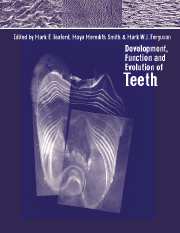Book contents
- Frontmatter
- Contents
- List of contributors
- Acknowledgements
- Part one Genes, molecules and tooth initiation
- 1 Homeobox genes in initiation and shape of teeth during development in mammalian embryos
- 2 Return of lost structure in the developmental control of tooth shape
- 3 Molecules implicated in odontoblast terminal differentiation and dentinogenesis
- 4 Enamel biomineralization: the assembly and disassembly of the protein extracellular organic matrix
- Part two Tooth tissues: development and evolution
- Part three Evolution of tooth shape and dentition
- Part four Macrostructure and function
- Index
3 - Molecules implicated in odontoblast terminal differentiation and dentinogenesis
Published online by Cambridge University Press: 11 September 2009
- Frontmatter
- Contents
- List of contributors
- Acknowledgements
- Part one Genes, molecules and tooth initiation
- 1 Homeobox genes in initiation and shape of teeth during development in mammalian embryos
- 2 Return of lost structure in the developmental control of tooth shape
- 3 Molecules implicated in odontoblast terminal differentiation and dentinogenesis
- 4 Enamel biomineralization: the assembly and disassembly of the protein extracellular organic matrix
- Part two Tooth tissues: development and evolution
- Part three Evolution of tooth shape and dentition
- Part four Macrostructure and function
- Index
Summary
Introduction
Histological organization, cytological features as well as functional aspects confer specificity to the odontoblasts. These post-mitotic, neural crest-derived cells are most often aligned in a single layer at the periphery of the dental pulp and secrete the organic components of predentin-dentin, including collagens and non-collagenous proteins. The functional odontoblasts, with one or more cytoplasmic processes extending into the predentindentin are connected by junctional complexes which probably do not completely seal the inter-odontoblastic spaces. The dentin extracellular matrix shows great similarities to bone matrix. However Smith and Hall (1990) strongly supported the phylogenetic emergence of distinct osteogenic and dentinogenic cell lineages.
Odontoblast terminal differentiation, allowing for dentinogenesis, represents the end point of a developmental sequence initiated during specification of neural crest-derived connective cell phenotypes and including patterning of the dental cells in the developing arches. Tooth class-specific histomorphogenesis leads to tooth-specific spatial distribution of functional odontoblasts (see Jernvall, 1995; Ruch, 1985, 1987, 1995a; Ruch et al., 1995 for reviews). Interestingly the analysis of the fate of uniparental mouse cells in chimeras indicated that the odontoblasts have a maternal origin (Fundele and Surani, 1994); thus genetic imprinting might affect odontogenesis.
Chapter 5 of this book examines the origin and early evolution of dentine, and Chapter 6 examines pulpodentinal interactions in the development and repair of dentine. Both include discussions of the initial developmental aspects of the odontoblast cell lineage. Here we concentrate exclusively on the physiological terminal differentiation of these cells. As far as reactionary and reparative dentins are concerned see Lesot et al., 1994; Smith et al., 1995; Tziafas, 1995.
- Type
- Chapter
- Information
- Development, Function and Evolution of Teeth , pp. 22 - 36Publisher: Cambridge University PressPrint publication year: 2000
- 3
- Cited by



